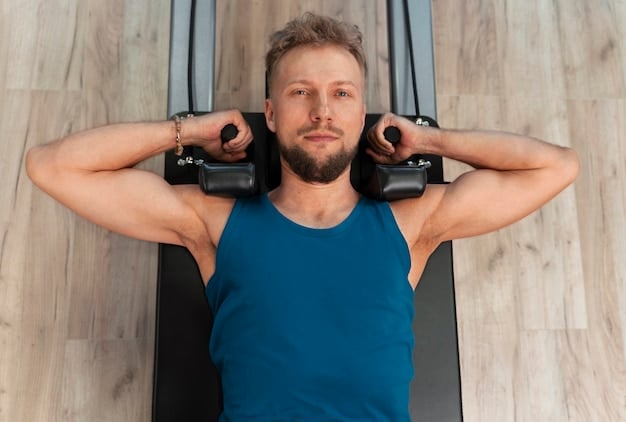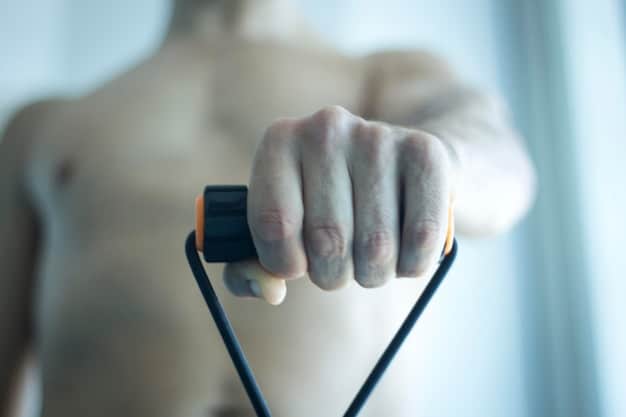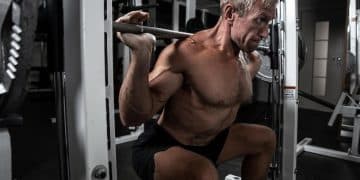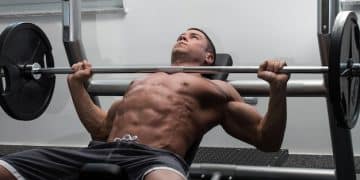Build a Bigger Chest: Incline-Focused Workout for Upper Pecs

A focused training approach specifically targeting the upper pectoral muscles through incline-based exercises is crucial for developing a fuller, more aesthetic, and proportionally balanced chest, enhancing overall strength and physique.
Seeking to finally develop that elusive upper chest mass? Many fitness enthusiasts find themselves with a well-developed lower and mid-chest but struggle to bring up the upper pecs. The key lies in understanding muscle anatomy and implementing a specialized routine. This guide delves into how to Build a Bigger Chest: The Incline-Focused Workout Routine for Upper Pecs, ensuring a balanced and impressive physique.
Understanding Upper Pec Anatomy and Its Importance
To effectively target any muscle group, a foundational understanding of its anatomy is crucial. The pectoral muscles, commonly known as the pecs, are comprised of two main parts: the pectoralis major and the pectoralis minor. When we discuss developing the “upper chest,” we are primarily referring to the clavicular head of the pectoralis major.
This distinct section of the pec muscle originates from the clavicle (collarbone) and inserts into the humerus (upper arm bone). Its primary function involves shoulder flexion and adduction, particularly when the arms are raised above 30 degrees. Neglecting this part often leads to an underdeveloped, “flattened” upper chest appearance, even if the rest of the pectoral region is well-developed. A balanced chest not only looks more aesthetically pleasing but also contributes to greater overall pushing strength and helps prevent muscular imbalances around the shoulder joint.
The Role of Incline Exercises
Incline exercises are fundamental for upper pec development because they optimally align the body to engage the clavicular head of the pectoralis major. When you perform movements on an incline bench, the angle of your torso relative to the ground shifts, altering the line of pull on your chest muscles. This setup specifically biases the upper fibers, making them the primary movers in the exercise.
- Optimized Fiber Recruitment: The incline angle directly targets the clavicular head, maximizing its activation.
- Improved Muscle Balance: Focusing on the upper pecs helps correct imbalances between the upper and lower chest.
- Enhanced Aesthetics: A well-developed upper chest contributes to a “fuller” and more powerful appearance of the entire chest.
Without sufficient attention to incline variations, even a rigorous chest routine can leave this crucial area lagging. It’s not just about doing chest exercises; it’s about doing the right variations with proper form to stimulate the desired muscle growth. The angle of the bench, the type of equipment used, and the controlled execution of each rep all play significant roles in the effectiveness of incline training.
Moreover, the shoulder joint itself benefits from this balanced development. Robust upper chest muscles contribute to shoulder stability and can protect against injuries frequently seen in pressing movements. This integrated approach ensures not only a visually impressive chest but also a stronger, more resilient upper body capable of handling heavier loads and more complex movements.
Key Principles for Maximizing Upper Pec Growth
While the selection of incline exercises is paramount, true upper pec growth hinges on adhering to several key training principles. Simply adding incline presses to your routine isn’t enough; how you execute these exercises, and the overall structure of your workout, will dictate your results.
Progressive Overload: This is arguably the most fundamental principle for muscle growth. To force your upper pecs to adapt and grow larger, you must continually challenge them with increasing resistance, volume, or time under tension. This could mean lifting heavier weights, performing more repetitions or sets, or reducing rest times between sets. Sticking to the same weights and reps indefinitely will lead to a plateau. Regularly assessing and slightly increasing the demands on your muscles is crucial for continuous progress.
Mind-Muscle Connection and Form
Focusing on the muscle you intend to work is critical, especially for the upper chest. During incline exercises, consciously try to feel your upper pecs contracting and stretching. This mind-muscle connection enhances motor unit recruitment, making your workouts more efficient and effective. Poor form, conversely, can shift tension away from the upper pecs and onto the shoulders or triceps, negating the exercise’s purpose.
- Controlled Movements: Avoid using momentum; lift and lower the weight slowly and deliberately.
- Optimal Range of Motion: Ensure a full stretch at the bottom and a strong contraction at the top of each rep.
- Shoulder Position: Keep your shoulders retracted and depressed to minimize their involvement and maximize pec activation.
Maintaining impeccable form not only ensures you target the intended muscle but also significantly reduces the risk of injury. It’s always better to lift lighter with perfect form than to go too heavy and compromise technique. The quality of your reps far outweighs the quantity or the weight on the bar when it comes to specific muscle hypertrophy.
Volume, Frequency, and Recovery
For optimal muscle growth, it’s essential to strike a balance between sufficient training volume and adequate recovery. For muscle groups like the chest, training 2-3 times per week can be highly effective, allowing for enough frequency to stimulate growth while providing ample time for recovery and repair.
Volume refers to the total amount of work done, typically calculated by sets x reps x weight. For hypertrophy, a moderate to high volume (e.g., 10-20 sets per muscle group per week) is often recommended. However, overtraining can be counterproductive, leading to diminished returns and increased injury risk. Listening to your body and ensuring proper nutrition and sleep are just as important as the workout itself. Muscles grow during recovery, not during the workout, so prioritize rest and fuel your body appropriately to support the demands of intense training.
The Incline-Focused Workout Routine for Upper Pecs
This routine is designed to prioritize the upper chest, incorporating a variety of incline exercises to hit the clavicular head from multiple angles. Remember to warm up thoroughly before starting and cool down afterward.
Workout Structure and Sets/Reps
The workout should begin with compound movements, which allow you to lift heavier weights and recruit more muscle fibers, followed by isolation exercises to further target and fatigue the upper pecs. Aim for 3-4 sets per exercise, with repetitions ranging from 6-12, depending on the specific movement and your strength level. Rest periods between sets should be 60-90 seconds to allow for sufficient recovery while maintaining intensity.
Remember that the primary goal is muscle hypertrophy, which responds well to a combination of heavy lifting and higher volume work. Therefore, vary your rep ranges occasionally to challenge your muscles in new ways. For instance, some weeks you might focus on heavier weights for 6-8 reps, while others you might use moderate weights for 10-12 reps. This variability can prevent plateaus and ensure continuous stimulus for growth.

Exercise Selection and Execution
Here’s a breakdown of the recommended exercises, emphasizing proper form for maximum upper pec activation:
- Incline Barbell Press: This is a cornerstone for upper chest development. Lie on an incline bench set at 30-45 degrees. Grip the bar slightly wider than shoulder-width. Lower the bar slowly to your upper chest, feeling a stretch, then forcefully press it back up, squeezing your upper pecs at the top. Avoid flaring elbows and keep your shoulders pressed into the bench.
- Incline Dumbbell Press: Offers a greater range of motion and allows for independent arm movement, addressing potential strength imbalances. Use a similar incline angle as the barbell press. Lower the dumbbells until you feel a good stretch in your chest, then press them up, bringing them slightly together at the top for an enhanced squeeze.
- Incline Dumbbell Flyes: An excellent isolation exercise for stretching and isolating the upper pecs. Use lighter weights. Keep a slight bend in your elbows, lower the dumbbells in an arc out to the sides until you feel a deep stretch, and then bring them back up in the same arc, focusing on squeezing your upper chest.
- Low-to-High Cable Crossovers: This movement targets the upper chest via adduction. Set the cables at the lowest point. Grab the handles and bring them up and across your body in an arc, aiming for a strong contraction in the upper pecs. Control the negative portion of the movement.
- Incline Push-ups (Feet Elevated): A bodyweight alternative or finisher. Elevating your feet on a bench or elevated surface increases the resistance on your upper chest, mimicking an incline press. Focus on a deep stretch and explosive push.
Prioritize form over weight for every single repetition. Each exercise should be performed with a deliberate tempo, focusing on the concentric (lifting) and eccentric (lowering) phases of the movement. The eccentric phase is particularly important for muscle growth, so control the weight on the way down, taking about 2-3 seconds for each lowering phase.
Advanced Techniques for Accelerated Upper Pec Growth
Once you’ve mastered the basic incline movements and established consistent progressive overload, incorporating advanced training techniques can provide new stimuli to further accelerate upper pec growth. These methods are designed to increase time under tension, enhance muscle fiber recruitment, and break through plateaus.
Drop Sets and Supersets
Drop Sets: Begin with your heaviest working weight, perform as many reps as possible until failure, then immediately reduce the weight (by 15-20%) and continue with more reps to failure. Repeat this process 2-3 times within a single set. This technique exhausts muscle fibers more thoroughly, increasing metabolic stress and promoting hypertrophy. For upper pecs, try this on the incline dumbbell press or incline machine press.
Supersets: Involves performing two exercises back-to-back with no rest in between. For upper chest, you could superset an incline compound movement with an incline isolation movement. For example, immediately follow incline barbell presses with incline dumbbell flyes. This maximizes efficiency and creates a powerful pump, enhancing blood flow and nutrient delivery to the muscles.
- Pre-exhaustion: Perform an isolation exercise (like incline dumbbell flyes) first to fatigue the target muscle, then immediately follow with a compound exercise (like incline barbell press). This ensures the upper pecs are fully engaged from the beginning of the compound lift, preventing other muscles (like triceps or shoulders) from taking over too early.
- Post-exhaustion: The reverse of pre-exhaustion. Perform a compound exercise first, then immediately follow with an isolation exercise. This is useful for completely fatiguing the upper pecs after they’ve been worked hard by the compound movement.
These techniques should be used judiciously, as they are highly intense and can lead to overtraining if applied too frequently. Incorporate them into your routine once or twice a week, perhaps using one per workout session, to provide a shock to your system and ignite new growth.
Partial Reps and Forced Reps
Partial Reps: After reaching full-range failure on an exercise, perform a few more repetitions through a partial range of motion (e.g., the top half of an incline press). This allows you to extend the set beyond typical failure. While not a substitute for full-range movements, partial reps can help accumulate additional time under tension and overload specific parts of the strength curve.
Forced Reps: Performed with the help of a spotter. When you reach muscular failure, your spotter provides just enough assistance to help you complete 1-2 additional repetitions. This pushes your muscles beyond their normal limits, stimulating further adaptation and growth. Ensure your spotter understands to provide minimal assistance to maximize the benefits and avoid injury.
Implementing these advanced techniques requires a good understanding of your body’s limits and the willingness to push through discomfort. They are not for beginners but can be highly effective tools for intermediate to advanced lifters looking to optimize their upper chest development.
Nutrition, Recovery, and Lifestyle for Peak Pec Growth
Building a bigger chest, especially the upper pecs, extends far beyond the gym. Your efforts in training must be complemented by a strategic approach to nutrition, recovery, and overall lifestyle. These factors are just as critical as the exercises themselves in dictating whether your muscles will recover, grow, and perform optimally.
Optimizing Your Diet for Muscle Growth
Muscle protein synthesis, the process by which muscles repair and grow, requires a consistent supply of quality nutrients. Protein is paramount; aim for at least 0.7-1 gram of protein per pound of body weight daily, distributed throughout your meals. Sources like lean meats, poultry, fish, eggs, dairy, and plant-based proteins are essential.
- Adequate Caloric Intake: To build muscle, you need to be in a slight caloric surplus, consuming more calories than you burn. This surplus provides the energy necessary for training and the building blocks for tissue repair.
- Complex Carbohydrates: These are your primary energy source for intense workouts. Include foods like oats, brown rice, sweet potatoes, and whole grains to fuel your training sessions and replenish glycogen stores.
- Healthy Fats: Crucial for hormone production, nutrient absorption, and overall health. Incorporate sources like avocados, nuts, seeds, and olive oil.
Hydration is another often-overlooked component. Water plays a vital role in nutrient transport, metabolic processes, and overall cellular function. Ensure you’re drinking plenty of water throughout the day, especially around your workouts.
The Critical Role of Sleep and Recovery
Muscles don’t grow during your workout; they grow during recovery, particularly during sleep. Aim for 7-9 hours of quality sleep per night. During deep sleep, your body releases growth hormone, which is essential for muscle repair and regeneration. Poor sleep can lead to elevated cortisol levels, muscle catabolism, and impaired recovery, hindering your progress.
Active recovery days, incorporating light activities like walking, stretching, or foam rolling, can also aid in blood flow and reduce muscle soreness, promoting faster recovery between intense chest sessions. Avoiding overtraining by not hitting the same muscle group with high intensity too frequently without adequate rest is also key. Listen to your body and incorporate rest days as needed.

Stress Management and Consistency
Chronic stress, whether from training or daily life, can negatively impact muscle growth by increasing cortisol levels. Implementing stress-reducing activities like meditation, yoga, or spending time in nature can support your recovery and overall well-being. Consistency is the ultimate determinant of success. Building a bigger chest isn’t about a single intense workout but about consistently adhering to your training, nutrition, and recovery plan over weeks, months, and even years. There will be plateaus and setbacks, but persistence and adherence to these fundamental principles will ultimately lead to the desired results.
Common Mistakes to Avoid in Upper Pec Training
While the desire to build a bigger upper chest is strong, many common pitfalls can derail progress and even lead to injury. Awareness of these mistakes is the first step toward correcting them and ensuring your efforts are productive.
Neglecting Proper Form and Mind-Muscle Connection
Perhaps the most prevalent mistake is sacrificing form for weight. Lifting too heavy on incline presses often leads to the shoulders and triceps dominating the movement, while the upper pecs remain under-stimulated. This can result in limited chest growth and increased risk of shoulder impingement or rotator cuff issues.
- Bouncing the Weight: Using momentum to lift the weight, particularly at the bottom of the rep, reduces tension on the muscle and increases injury risk.
- Flaring Elbows: Too wide an elbow flare during pressing movements puts excessive stress on the shoulder joint rather than keeping tension on the pecs.
- Lack of Focus: Going through the motions without consciously engaging the upper pecs means you’re not maximizing fiber recruitment. Always visualize and feel the muscle working.
A good rule of thumb is to reduce the weight if you cannot perform a rep with control and feel it primarily in your upper chest. The mind-muscle connection is not just a concept; it’s a critical component of effective hypertrophy training.
Insufficient Incline Angle and Variety
Some individuals set the incline bench too high, turning an upper chest exercise into more of a front shoulder exercise. Conversely, a too-flat incline may not effectively target the upper pecs. The optimal range is typically 30-45 degrees. Experiment within this range to find what feels best for your anatomy and shoulder health.
Relying on just one incline exercise can also limit development. The upper pecs, like any muscle group, benefit from varied stimuli. Sticking only to incline barbell press, for example, might miss out on the unique benefits offered by incline dumbbells (greater range of motion) or cables (constant tension from different angles). Incorporating a diverse range of incline movements ensures comprehensive targeting of the clavicular head.
Ignoring Progressive Overload and Recovery
Stagnation often occurs when lifters fail to implement progressive overload. If you’re using the same weights and reps month after month, your muscles have no reason to adapt and grow. Continuously challenging your body with slightly heavier weights, more reps, or increased training volume is non-negotiable for sustained growth.
Equally detrimental is insufficient recovery. Overtraining, inadequate sleep, and poor nutrition will sabotage even the most perfectly executed workouts. Muscles need time and resources to repair and grow stronger. Pushing too hard without sufficient rest can lead to burnout, decreased performance, and increased susceptibility to injury. Remember that growth happens outside the gym.
Avoiding these common mistakes, coupled with consistent, disciplined training and a holistic approach to recovery and nutrition, will significantly enhance your journey toward building a bigger, more defined upper chest.
| Key Point | Brief Description |
|---|---|
| 🎯 Upper Pec Focus | Prioritize incline exercises to specifically target the clavicular head of the pectoralis major for balanced chest development. |
| 🔝 Progressive Overload | Continuously challenge muscles by increasing weight, reps, or volume to stimulate ongoing growth and prevent plateaus. |
| 🧠 Mind-Muscle Connection | Consciously feel the upper pecs working with controlled movements to ensure optimal muscle fiber recruitment and effectiveness. |
| 🛌 Recovery & Nutrition | Adequate sleep, proper hydration, and a protein-rich diet are fundamental for muscle repair, growth, and overall performance. |
Frequently Asked Questions
▼
The optimal angle for an incline press to target the upper chest is generally between 30 and 45 degrees. Angles lower than 30 degrees might engage more of the middle chest, while angles steeper than 45 degrees tend to shift activation more towards the anterior deltoids (front shoulders). Experiment within this range to find the angle that allows you to feel the strongest contraction in your upper pecs.
▼
For most individuals aiming for muscle hypertrophy, training the upper chest 2-3 times per week is highly effective. This frequency allows for sufficient stimulus for growth while providing adequate time for recovery between sessions. Ensure each session includes sufficient volume (sets and reps) and that you are progressively overloading the muscles over time for continuous gains.
▼
Yes, it is possible to build your upper chest with bodyweight exercises, primarily through variations of push-ups. elevated feet push-ups (incline push-ups) are particularly effective as they mimic the angle of an incline press, biasing the upper pecs. To progressively overload, you can increase the elevation of your feet, add pauses, perform slower eccentric phases, or decrease rest times.
▼
An effective incline-focused chest routine should include a mix of compound and isolation movements. Key exercises are incline barbell press, incline dumbbell press, incline dumbbell flyes, and low-to-high cable crossovers. You can also incorporate incline machine presses and elevated feet push-ups. Varying your exercises and consistently applying progressive overload will lead to comprehensive upper chest development.
▼
The timeline for noticeable upper chest growth varies widely based on individual factors like genetics, training consistency, nutrition, and recovery. Generally, with consistent and proper training, you might start to see subtle changes within 4-8 weeks. More significant and visible improvements typically require several months (3-6+) of dedicated effort. Patience and adherence to your program are crucial.
Conclusion
Developing a well-defined upper chest is not merely a matter of aesthetics; it’s fundamental for creating a balanced, strong physique and ensuring long-term shoulder health. By understanding the anatomy of the upper pecs, strategically incorporating incline-focused exercises, committing to progressive overload, and prioritizing meticulous form, you lay the groundwork for significant growth. Coupled with a disciplined approach to nutrition, adequate sleep, and consistent effort, the elusive upper chest can indeed be transformed. Remember, genuine muscle development is a journey of consistency, attention to detail, and a holistic approach to fitness and well-being. Implement these strategies, listen to your body, and observe the transformative power of a targeted training regimen.





